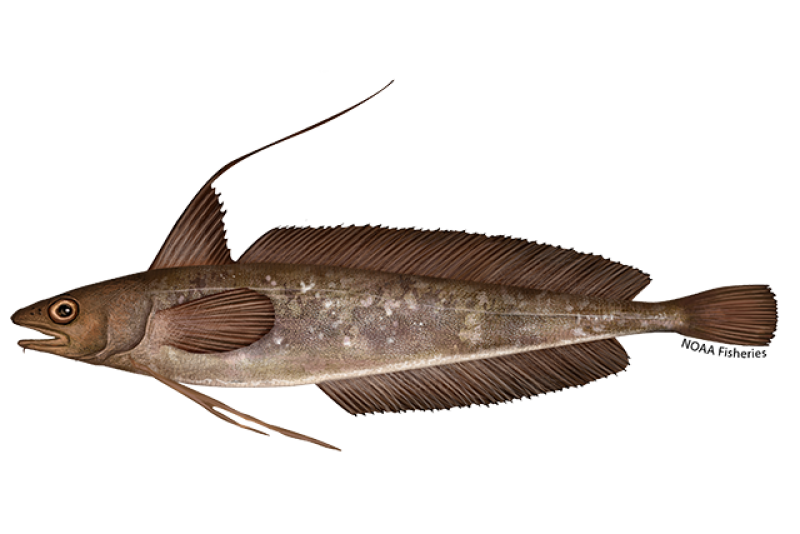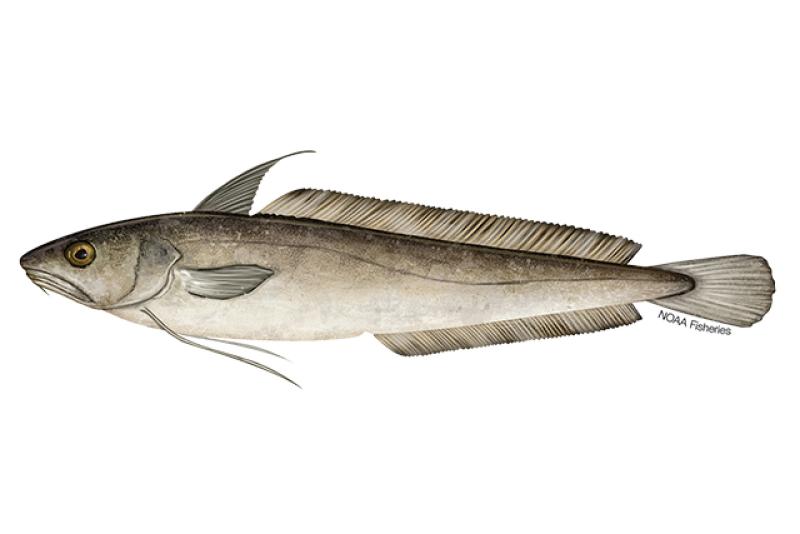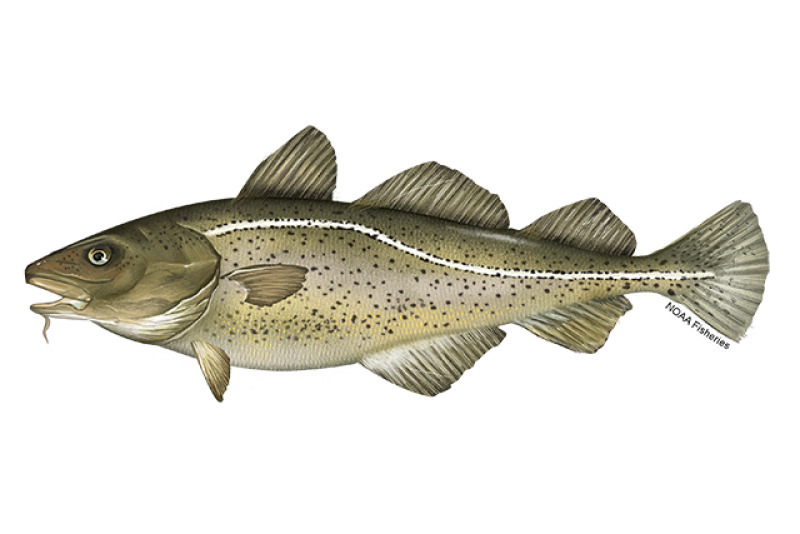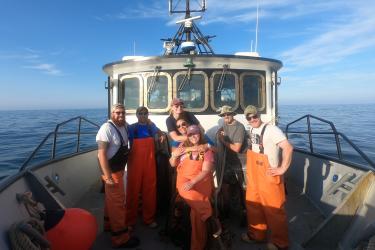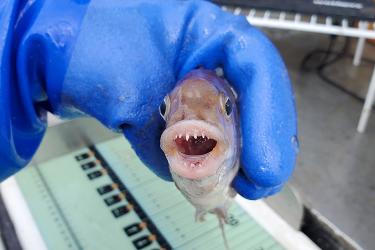Silver Hake
About the Species
There is little to no separation of silver hake and offshore hake in the market, and both are generally sold under the name “whiting.” The whiting fishery in the United States operates from Maine to Cape Hatteras, North Carolina. Along with red hake, whiting are part of the small-mesh multispecies fishery, which is managed primarily through a series of exemptions from the Northeast Multispecies Fishery Management Plan (or groundfish fishery). The directed commercial fishery is conducted with small-mesh trawl gear with a number of specific requirements to reduce bycatch of larger groundfish species. There are two stocks of silver hake (northern and southern), and one stock of offshore hake, which primarily co-occurs with the southern stock of silver hake. The market for small-mesh multispecies is human consumption and as bait. U.S. wild-caught whiting is a smart seafood choice because it is sustainably managed and responsibly harvested under U.S. regulations. Implementing regulations are found at 50 CFR part 648 subpart F.

Population
The stocks are not overfished.

Fishing Rate
Not subject to overfishing.

Habitat Impact
Fishing gears used to harvest silver hake have minimal impacts on habitat.

Bycatch
Raised-footrope trawls are required in designated areas when targeting hake to minimize bycatch of other species.
Population Status
- There are two stocks of silver hake: the Gulf of Maine/Northern Georges Bank stock and the Southern Georges Bank/Mid-Atlantic stock. According to the most recent stock assessments:
- The Gulf of Maine/Northern Georges Bank stock is not overfished and not subject to overfishing (2023 stock assessment). Summary stock assessment information can be found on Stock SMART.
- The Southern Georges Bank/Mid-Atlantic stock is not overfished and not subject to overfishing (2023 stock assessment). Summary stock assessment information can be found on Stock SMART.
Appearance
- Silver hake are silvery in color, brownish on the back and whitish on the belly, with black speckles on the back and black inside the mouth.
- They have large heads for their size and sharp teeth.
- They have long pectoral fins and are fast swimmers.
Biology
- Female silver hake are serial spawners, producing and releasing up to three batches of eggs in a single spawning season.
- Spawning areas include the coastal region of the Gulf of Maine from Cape Cod to Grand Manan Island, southern and southeastern Georges Bank, and the southern New England area south of Martha’s Vineyard.
- Their peak spawning occurs earlier in the south (May to June) than in the north (July to August).
- More than half of 2-year-old silver hake and virtually all 3-year-olds are sexually mature.
- Silver hake can live as long as 14 years, although few fish older than age 6 have been observed in U.S. waters in recent years.
- They can grow to be more than 28 inches long and up to 5 pounds.
- Silver hake are important to the northwest Atlantic ecosystem both as prey and predators.
- They are voracious predators and feed on fish, crustaceans, and squid.
Where They Live
Range
- Silver hake are found in the Northwest Atlantic Ocean and range primarily from Newfoundland to South Carolina.
Habitat
- In U.S. waters, two stocks have been identified. The northern stock of silver hake inhabits the waters of the Gulf of Maine and Northern Georges Bank, and the southern stock inhabits the waters of Southern Georges Bank and the Mid-Atlantic Bight.
- As nocturnal, semi-pelagic predators, silver hake move up in the water column to feed at night, primarily between dusk and midnight. They return to rest on the ocean bottom during the day, preferring sandy, muddy, or pebbly ocean bottoms.
- Silver hake migrate in response to seasonal changes in water temperatures, moving toward shallow, warmer waters in the spring.
- They spawn in these shallow waters during late spring and early summer and then return to deeper waters in the autumn.
- Older, larger silver hake prefer deeper waters.
- During the summer, portions of both stocks can be found on Georges Bank.
- During the winter, fish in the northern stock move to deep basins in the Gulf of Maine, while fish in the southern stock move to outer continental shelf and slope waters.
- Silver hake are widely distributed, and have been observed at temperature ranges of 2 to 17° C (36 to 63° F) and depth ranges of 11 to 500 meters (36 to 1,640 feet). However, they are most commonly found in temperatures between 7 and 10° C (45 to 50° F).
Fishery Management
- NOAA Fisheries and the New England Fishery Management Council manage the silver hake fishery.
- Silver hake are managed and assessed as two stocks: The Gulf of Maine and Northern Georges Bank (northern stock) and the Southern Georges Bank and Mid-Atlantic (southern stock). The southern stock includes southern silver hake and offshore hake.
- Managed under the Northeast Multispecies Fishery Management Plan for Small Mesh Multispecies:
- Permitting requirements.
- A cap on the amount of groundfish bycatch that fishing vessels can take.
- Seasonal and spatial limitations throughout the Gulf of Maine and Georges Bank on fishing with small mesh.
- Trip limits by mesh size and area.
- In-season trip limit reductions and catch monitoring help prevent excessive catches.
- The small-mesh multispecies fishery is managed primarily through a series of exemptions from the Northeast Multispecies Fishery Management Plan. Exempted fisheries allow vessels to fish for specific species, such as silver hake, in designated areas using mesh sizes smaller than the minimum mesh size allowed under the Regulated Mesh Area regulations.
Harvest
- Commercial fishery:
- In 2023, commercial landings of silver hake totaled 9.6 million pounds and were valued at $8.1 million, according to the NOAA Fisheries commercial fishing landings database.
- Silver hake is part of the small-mesh multispecies management unit, along with red hake and offshore hake, which are collectively referred to as “whiting."
- The small-mesh multispecies fishery in the United States operates from Maine to Cape Hatteras, North Carolina.
- Gear types, habitat impacts, and bycatch:
- Fishermen using small-mesh trawl gear to catch silver hake must comply with a number of specific requirements to reduce bycatch of larger groundfish species.
- In designated areas, fishermen are required to use raised-footrope trawls, which are designed to keep the net off the bottom to reduce bycatch of flatfish and other species.
- Discard rates for silver hake are relatively low (10% of the northern silver hake landings and 21% of the southern whiting and offshore hake landings).
- Approximately 60 percent of the red hake caught as bycatch in the whiting fishery are discarded.
- Recreational fishery:
- Recreational fishermen do not target silver hake but sometimes catch them incidentally while fishing for other groundfish.
- There are currently no restrictions on recreational possession, size, or gear type for silver hake caught recreationally in federal waters.
- There are no specific areas for the recreational fishery.
Scientific Classification
- Silver hake are found in the Northwest Atlantic Ocean and range primarily from Newfoundland to South Carolina.
- In U.S. waters, two stocks have been identified. The northern stock of silver hake inhabits the waters of the Gulf of Maine and Northern Georges Bank, and the southern stock inhabits the waters of Southern Georges Bank and the Mid-Atlantic Bight.
- As nocturnal, semi-pelagic predators, silver hake move up in the water column to feed at night, primarily between dusk and midnight. They return to rest on the ocean bottom during the day, preferring sandy, muddy, or pebbly ocean bottoms.
- Silver hake migrate in response to seasonal changes in water temperatures, moving toward shallow, warmer waters in the spring.
- They spawn in these shallow waters during late spring and early summer and then return to deeper waters in the autumn.
- Older, larger silver hake prefer deeper waters.
- During the summer, portions of both stocks can be found on Georges Bank.
- During the winter, fish in the northern stock move to deep basins in the Gulf of Maine, while fish in the southern stock move to outer continental shelf and slope waters.
- Silver hake are widely distributed, and have been observed at temperature ranges of 2 to 17° C (36 to 63° F) and depth ranges of 11 to 500 meters (36 to 1,640 feet). However, they are most commonly found in temperatures between 7 and 10° C (45 to 50° F).
Fishery Management
- NOAA Fisheries and the New England Fishery Management Council manage the silver hake fishery.
- Silver hake are managed and assessed as two stocks: The Gulf of Maine and Northern Georges Bank (northern stock) and the Southern Georges Bank and Mid-Atlantic (southern stock). The southern stock includes southern silver hake and offshore hake.
- Managed under the Northeast Multispecies Fishery Management Plan for Small Mesh Multispecies:
- Permitting requirements.
- A cap on the amount of groundfish bycatch that fishing vessels can take.
- Seasonal and spatial limitations throughout the Gulf of Maine and Georges Bank on fishing with small mesh.
- Trip limits by mesh size and area.
- In-season trip limit reductions and catch monitoring help prevent excessive catches.
- The small-mesh multispecies fishery is managed primarily through a series of exemptions from the Northeast Multispecies Fishery Management Plan. Exempted fisheries allow vessels to fish for specific species, such as silver hake, in designated areas using mesh sizes smaller than the minimum mesh size allowed under the Regulated Mesh Area regulations.
Harvest
- Commercial fishery:
- In 2023, commercial landings of silver hake totaled 9.6 million pounds and were valued at $8.1 million, according to the NOAA Fisheries commercial fishing landings database.
- Silver hake is part of the small-mesh multispecies management unit, along with red hake and offshore hake, which are collectively referred to as “whiting."
- The small-mesh multispecies fishery in the United States operates from Maine to Cape Hatteras, North Carolina.
- Gear types, habitat impacts, and bycatch:
- Fishermen using small-mesh trawl gear to catch silver hake must comply with a number of specific requirements to reduce bycatch of larger groundfish species.
- In designated areas, fishermen are required to use raised-footrope trawls, which are designed to keep the net off the bottom to reduce bycatch of flatfish and other species.
- Discard rates for silver hake are relatively low (10% of the northern silver hake landings and 21% of the southern whiting and offshore hake landings).
- Approximately 60 percent of the red hake caught as bycatch in the whiting fishery are discarded.
- Recreational fishery:
- Recreational fishermen do not target silver hake but sometimes catch them incidentally while fishing for other groundfish.
- There are currently no restrictions on recreational possession, size, or gear type for silver hake caught recreationally in federal waters.
- There are no specific areas for the recreational fishery.
Scientific Classification
| Kingdom | Animalia | Phylum | Chordata | Class | Actinopterygii | Order | Gadiformes | Family | Merlucciidae | Genus | Merluccius | Species | bilinearis |
|---|
Last updated by NOAA Fisheries on 05/08/2025
Featured News

Research Addresses Need for Bottom Trawl Survey Gear Standardization

Recreational Fishing Regulations
Hakes/whiting are not typically targeted recreationally, but are legal to possess. There are currently no recreational possession, size, or gear restrictions for hakes/whiting caught in federal waters. There are also no specific areas designated for a whiting recreational fishery.
Recreational anglers must still comply with minimum fish size regulations for all recreational fisheries. Recreational anglers will need to get a general recreational fishing license either through your state or through NMFS to fish recreationally for marine species. Visit our permit office or recreational fishing pages for more information.
Reporting A Recreational Catch
This is not applicable for the whiting (small-mesh multispecies) fishery. Visit the Greater Atlantic Region's recreational fishing page for more information about recreational reporting in general.
Last updated by NOAA Fisheries on 05/08/2025
Commercial Fishing Regulations
Possession and Size Requirements
Silver hake and offshore hake are often grouped together and collectively referred to as "whiting.” Possession limits in this fishery can vary depending upon the stock, mesh size of the gear being used, and the exemption area being fished. The table below shows the general possession limits for the fishery by target stock and mesh size.
Small-Mesh Multispecies Possession Limits by Stock and Mesh Size
| Northern Silver Hake Limit | Southern Whiting Limit | |
| Mesh size <3 inches | 15,000 lb | 15,000 lb |
| Mesh size ≥3 inches | 30,000 lb | 40,000 lb |
Note: These limits may differ within specific exemption areas. Please check the Exempted Fishing tab for more information.
There are no fish size limits in the small-mesh multispecies fishery (all hakes, all stocks).
Current Whiting Specifications (May 1, 2024 to April 30, 2026)
| Stock | Northern Silver Hake | Southern Whiting* |
|---|---|---|
| Overfishing Limit (OFL) | 79,473 | 35,419 |
| Acceptable Biological Catch (ABC) | 40,868 mt | 20,149 mt |
| Annual Catch Limit (ACL) | 38,825 mt | 19,142 mt |
| Total Allowable Landings (TAL) | 31,347 mt | 13,881 mt |
*Note: Southern Whiting = Southern Silver Hake + Offshore Hake. There is not enough scientific information to produce catch limits for offshore hake, which are most often landed mixed with southern silver hake. Therefore, the southern silver hake ABC is increased by four percent to account for offshore hake.
Reporting A Commercial Catch
Catch Reporting and Vessel Trip Reports (VTR)
VTRs must be maintained on board the vessel and submitted to NOAA fisheries with a record of all fishing activity for each month. The reports must be submitted (postmarked, or received by NOAA Fisheries) by Tuesday of the week after the fishing trip ends. Copies of VTRs must be retained on board the vessel for 1 year after the date of the last entry on the log and otherwise retained for 3 years after the date of the last entry on the log. Reports can also be submitted electronically through our online reporting page.
Vessel Monitoring System (VMS)
There are no specific VMS requirements for vessels fishing in an exempted fishery for small-mesh multispecies. However, if the vessel has VMS requirements because of other permits held by the vessel, the vessel must declare ‘out of fishery’ (DOF) on their VMS unit when fishing for small-mesh multispecies within an exempted fishery. In some cases, another appropriate VMS code may be used, depending on the other permits and other species that may be landed on that trip or within the exempted fishery. For more information about VMS in the small-mesh multispecies fishery or assistance with your VMS codes, call our Office of Law Enforcement VMS team at (978) 281–9149.
Other Reporting Information
All federally permitted vessels are obligated to carry an observer if randomly selected by the National Observer Program.
Commercial Gear Information
For the most part, the gear requirements for the small-mesh multispecies fishery are determined by the exemption or regulated mesh area being fished. The following are some standard small-mesh requirements that may be applicable.
Raised Footrope Trawl
There are some standardized requirements for the raised footrope trawl that are required for four of the northern exempted fisheries (Raised Footrope Trawl Exempted Whiting Fishery [Gulf of Maine (GOM) and/or adjacent to Cape Cod] and Small-Mesh Areas 1 and 2). The trawl gear must be configured in such a way that, when towed, the footrope is not in contact with the ocean bottom. Vessels are presumed to be fishing in such a manner if their trawl gear is designed as specified below:
Headrope
- Floats with a minimum diameter of eight inches; must be attached along the entire length of the headrope with a maximum spacing of four feet between each float.
Ground Gear
- Must be all bare wire; not larger than 1/2 inch in diameter for the top leg, not larger than 5/8 inch in diameter for the bottom leg, and not larger than 3/4 inch in diameter for the ground cables.
- Top legs must be equal with bottom legs, with no extensions.
- Total length of the ground cables must not be greater than 40 fathoms from the doors to the wing ends.
Footrope
- Must be longer than the headrope (but not more than 20 feet longer than the headrope), and must be rigged so that it does not contact the bottom while fishing.
Drop Chains
- Must be used with or without a chain sweep.
- Must be 42 inches in length or greater.
- The maximum size drop chain stock when used with a sweep is 5/16 inch; or 3/8-inch stock when no sweep is used.
- Only bare chain may be used; cookies or additional weights on the drop chains are prohibited.
- Must be hung from the center of the footrope and each corner (the quarter, or the junction of the bottom wing to the belly at the footrope).
- Must be hung at 8-foot intervals along the footrope from the corners to the wing ends.
Sweep Specifications and Optional Sweepless Trawl
The raised footrope trawl may be used with or without a chain sweep. The sweep, if used, must be rigged in the following manner:
- The sweep must be bare chain, the same length as the footrope. (Note: The required drop chains at the wing ends of the footrope effectively make the sweep seven feet longer than the footrope.)
- The maximum size of the sweep is 5/16-inch stock chain.
- The sweep must be attached to the ends of the drop chains.
- The center of the sweep must be attached to the drop chain from the center of the footrope.
- The attachment points of each drop chain on the sweep and the footrope must be the same distance from the center drop chain attachments.
- The ends of the sweep must be attached to the drop chains at the end of the footrope.
Administrative Information
Vessels fishing in the Cultivator Shoal, Raised Footrope Trawl, or Southern New England Exemption areas, and are transiting through the GOM and Georges Bank (GB) Regulated Mesh Area (RMA), with nets with mesh smaller than the minimum mesh size, and small mesh exempted species aboard, must obtain the GOM/GB RMA Transiting Letter of Authorization (LOA) by contacting the Greater Atlantic Region Permit Office at (978) 281-9370.
Vessels fishing for whiting with small-mesh in the Raised Footrope Trawl Whiting Exempted Fishery Areas must carry an LOA issued by the Regional Administrator, valid for a minimum of seven days. Participating vessels may withdraw from the program no earlier than seven days from the date of enrollment. LOAs and withdrawals may be obtained from the Greater Atlantic Region Permit Office at (978) 281-9370.
Note: Vessels participating in the Raised Footrope Trawl Whiting Fishery may participate in other small-mesh exemption areas provided they adhere to the more restrictive gear, possession, and other requirements for the entire participation period specified in the LOA.
Last updated by NOAA Fisheries on 05/08/2025
Seafood Facts

Is Silver Hake Sustainable?
U.S. wild-caught silver hake is a smart seafood choice because it is sustainably managed and responsibly harvested under U.S. regulations.
Availability
Year-round.
Source
U.S. wild-caught from Maine to South Carolina.
Taste
Mild and slightly sweet.
Texture
Hakes have softer flesh and are less flaky than other whitefish such as cod, haddock, and pollock.
Color
Raw and cooked hake is white to off-white.
Health Benefits
Silver hake is a good source of selenium, vitamin B, magnesium, and protein.
Nutrition Facts
Servings: 1; Serving Weight: 100 g (raw); Calories: 90 ; Protein: 18.31 g; Total Fat: 1.31 g; Total Saturated Fatty Acids: 0.247 g; Carbohydrate: 0 g; Total Sugars: 0 g; Total Dietary Fiber: 0 g; Cholesterol: 67 mg; Selenium: 32.1 mcg; Sodium: 72 mgMore Information
Hake Recipes
Looking for ways to add white fish like hake into your rotation? If you need some cooking inspiration, browse these recipes for easy fish sticks, crab-stuffed hake, and more!
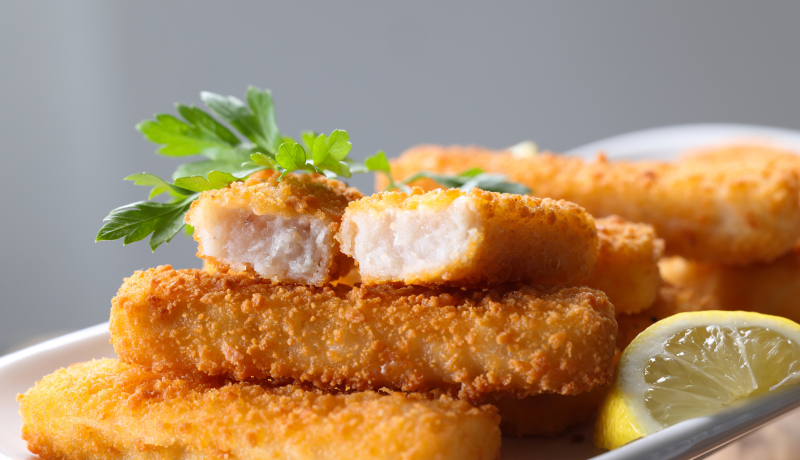
Last updated by NOAA Fisheries on 05/08/2025
Seafood News
 Celebrate Culinary Arts Month with a sustainable seafood recipe for every month of the year.
Celebrate Culinary Arts Month with a sustainable seafood recipe for every month of the year.
What Your Birth Month Says About Your Next Seafood Recipe
 Fresh-caught taʻape on ice. Credit: Conservation International Hawaiʻi.
Fresh-caught taʻape on ice. Credit: Conservation International Hawaiʻi.
Reducing Waste and Feeding Communities in Hawaiʻi with a Whole Fish Approach
 Chef Tyler Hadfield’s Curried Skate Wings with Tomato-Masala Chutney
Chef Tyler Hadfield’s Curried Skate Wings with Tomato-Masala Chutney
Ring In the New Year With These Crowd-Favorite Seafood Recipes
 NOAA Fisheries, in collaboration with Blue Ocean Mariculture, is conducting a multi-year pilot study to evaluate observational methods and tools for studying Hawaiian monk seal behavior. Courtesy of Blue Ocean Mariculture
NOAA Fisheries, in collaboration with Blue Ocean Mariculture, is conducting a multi-year pilot study to evaluate observational methods and tools for studying Hawaiian monk seal behavior. Courtesy of Blue Ocean Mariculture
AI Meets Aquaculture to Study Hawaiian Monk Seal Interactions With Net Pens
Exempted Fishing
What is an Exempted Fishery?
Exempted fisheries allow vessels to fish for specific species without being subject to certain northeast (NE) multispecies regulations, including days-at-sea, provided the bycatch of regulated species is minimal. To be approved and implemented, exemption programs must have demonstrated that incidental catch of NE multispecies is less than five percent of the total catch, by weight, and that the exemption will not jeopardize fishing mortality objectives.
Small-Mesh Multispecies Fishery Exemptions
The small-mesh multispecies (whiting) fishery is primarily managed under a series of fishery exemptions to the NE Multispecies Fishery Management Plan (FMP). As a result, the majority of the fishery (specific possession limits, gear restrictions, and other management measures) is determined by the exemption area or regulated mesh area being fished.
Within the Gulf of Maine (GOM) and Georges Bank (GB) Regulated Mesh Areas (RMA) there are five specific exempted fishing areas for small-mesh multispecies/whiting (see map at the bottom of the page), and whiting may be harvested throughout the entire Southern New England (SNE) and Mid-Atlantic (MA) RMAs, under specific requirements.
More specific details for each area can be found on the linked pages within the table below. A Letter of Authorization (LOA) is required to participate in some of these exempted fishing areas. LOAs can be obtained from our Permits Office at (978) 282-8438, or online by visiting our permits site.
Small-Mesh Multispecies Exemption Areas
| Area Name | Season | LOA Required? |
|---|---|---|
| GOM Grate Raised Footrope Trawl Whiting Fishery Exemption Area | July 1 - November 30 | No |
| Cultivator Shoal Whiting Fishery Exemption Area | June 15 - October 31 | Yes |
| Small Mesh Areas 1 & 2 | SMA 1: July 15 - November 15 SMA 2: January 1 - June 30 | No |
| Raised Footrope Trawl Exempted Whiting Fishery Areas (Cape Cod) | September 1 - November 20 / December 31 | Yes |
| SNE Exemption Area | Year round | No |
| Mid-Atlantic Exemption Area | Year round | No |
Note: Whiting (combined silver hake and offshore hake) are also allowed as bycatch in the Northern Shrimp Fishery up to an amount equal to the weight of shrimp on board, not to exceed 3,500 pounds. Whiting on board a vessel subject to this possession limit must be separated from other species of fish and stored so as to be readily available for inspection.
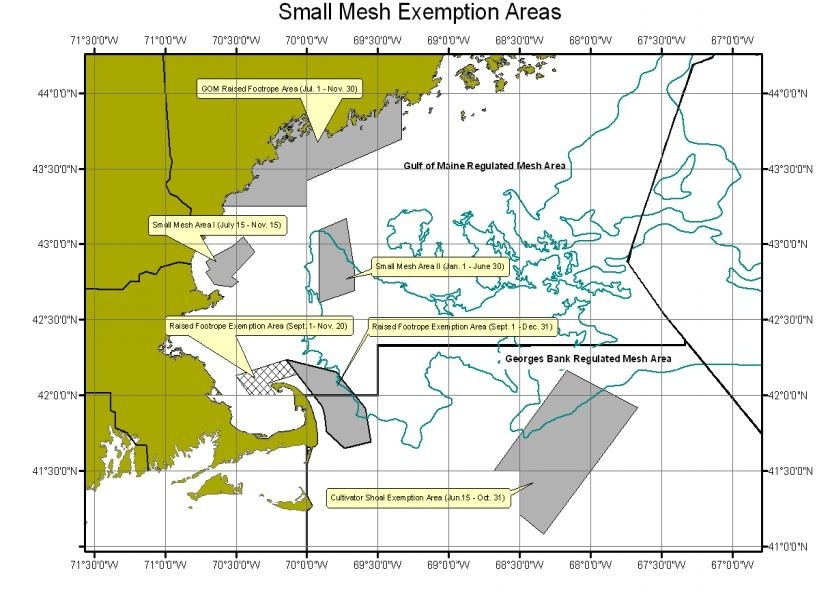
Last updated by NOAA Fisheries on 05/08/2025
Management Overview
The small-mesh multispecies fishery is managed by the New England Fishery Management Council, with NOAA Fisheries serving as the implementing body for rules and regulations within the fishery.
The fishery is managed as five stocks of three species of hakes: Northern silver hake, southern silver hake, northern red hake, southern red hake, and offshore hake. Silver hake and offshore hake are often grouped together and collectively referred to as "whiting."
The fishing year runs from May 1 through April 30; however, because this fishery primarily operates through exemptions from the Northeast Multispecies Fishery Management Plan, the timing of most targeted fishing is highly dependent upon the seasons of specific exemption areas. Specific possession limits, gear restrictions, and other management measures are also often determined by the exemption area or regulated mesh area being fished.
The northern hake stocks are found within the Gulf of Maine (GOM) and northern Georges Bank (GB) regulated mesh areas (RMA), and the southern stocks are within the southern GB, southern New England (SNE) and Mid-Atlantic (MA) RMAs. For more information on exempted fishing areas, visit the Exempted Fishing tab on this page.

Control Date for the Small-Mesh Multispecies Fishery: November 28, 2012.
Management Plans
Specifications/Quotas
The Small-Mesh Multispecies Fishery Management Plan (FMP) requires the annual specification of catch and harvest limits for up to three years at a time. If specifications are not in place at the start of the fishing year, the existing specifications roll over until new regulations are finalized.
Current Whiting Specifications (May 1, 2019 to April 30, 2020)
| Stock | Northern Silver Hake | Southern Whiting* |
|---|---|---|
| Overfishing Limit (OFL) | 58,350 mt | 31,180 mt |
| Acceptable Biological Catch (ABC) | 31,030 mt | 19,395 mt |
| Annual Catch Limit (ACL) | 29,475 mt | 18,425 mt |
| Total Allowable Landings (TAL) | 26,604 mt | 14,465 mt |
*Note: Southern Whiting = Southern Silver Hake + Offshore Hake. There is not enough scientific information to produce catch limits for offshore hake, which are most often landed mixed with southern silver hake. Therefore, the southern silver hake ABC is increased by four percent to account for offshore hake.
Inseason Actions
If 90 percent of either the northern silver hake or southern whiting TALs is projected to be reached or exceeded, the possession limit of that stock will be reduced to the incidental level of 2,000 lb per trip for the remainder of the fishing year.
Accountability Measures (AM)
If a small-mesh multispecies ACL is exceeded in a given fishing year, the inseason accountability measure adjustment trigger for that stock will be reduced in subsequent fishing years by one percent for each one percent by which the ACL was exceeded.
For example: If the inseason adjustment trigger is 90 percent, and the ACL is exceeded by 5 percent, the adjustment trigger for the stock whose ACL was exceeded would be reduced to 85 percent for subsequent fishing years.
Regulatory History
- 1987 – Amendment 1 decreased the area for the whiting exempted fishery, and made several other changes to the NE multispecies fishery.
- 1991 – Amendment 4 incorporated silver hake and red hake into the NE Multispecies FMP, and established the Cultivator Shoals Experimental Whiting Fishery.
- 1994 – Framework Adjustment 6 aimed to reduce catch of juvenile whiting in Cultivator Shoals by increasing the minimum mesh size from 2.5” to 3” for that area.
- 1995 – Framework Adjustment 9 established Small-Mesh Areas 1 and 2 and their seasons.
- 1996 – Amendment 7 established additional bycatch species in Cultivator Shoals Exemption Area, as well as many other catch limits and management measures within the NE Multispecies FMP.
- 2000 – Amendment 12 established essential fish habitat (EFH) designations, differential possession limits based on mesh size, a transfer-at-sea provision, year 4 default measures, and included offshore hake into the NE Multispecies FMP.
- 2000 – Framework Adjustment 32 modified the whiting mesh size/possession limit enrollment program and allowed the use of a net strengthener.
- 2000 – Framework Adjustment 35 established the Cape Cod Bay Raised Footrope Trawl area and season.
- 2002 – Modifications to Amendment 12 delayed year 4 default measures.
- 2002 – Modification to Framework 35 modified boundaries and season of Cape Cod Bay Raised Footrope Trawl Area, added another area East of Cape Cod, and adjusted area seasons.
- 2003 – Framework Adjustment 37 eliminated the year 4 default measures, adjusted area seasons, possession limits and species allowed for retention, and clarified the transfer-at-sea provisions.
- 2003 – Advanced Notice of Proposed Rulemaking established new small-mesh multispecies control date of March 25, 2003.
- 2003 – Framework Adjustment 38 established Inshore GOM Whiting Exemption Area, required grate raised footrope trawl, and adjusted area possession limits, species for retention, and seasons.
- 2006 – Amendment 14 scoping measures included for consideration included: Limited entry for commercial vessels, hard total allowable catch (TAC), dedicated access privileges, and recreational measures.
- 2006 – Advanced notice of proposed rulemaking reaffirmed March 25, 2003, control date.
- 2012 – Secretarial Amendment to establish annual catch limits and accountability measures for the small-mesh multispecies fishery.
- 2013 – Amendment 19 modified management measures in the small-mesh multispecies fishery; including the accountability measures, the year-round possession limits, and total allowable landings process.
Last updated by NOAA Fisheries on 05/08/2025
Science Overview
NOAA Fisheries conducts various research activities on the biology, behavior, and population health of silver hake. The results of this research are used to inform management decisions for this species.
For detailed information about stock status, management, assessments, and resource trends, you can search for silver hake, and any other species of interest, using NOAA’s StockSMART web tool.
More Information
Recent Science Blogs
Last updated by NOAA Fisheries on 05/08/2025
Documents
Age Determination Methods for Northwest Atlantic Species
This manual documents age determination techniques used by staff at the Woods Hole Laboratory to…
Data & Maps
Accuracy and Precision of Fish Ages - Northeast
It is important to ensure consistency in fish ages used in fish population assessments. The Fishery…
Last updated by NOAA Fisheries on 05/08/2025


